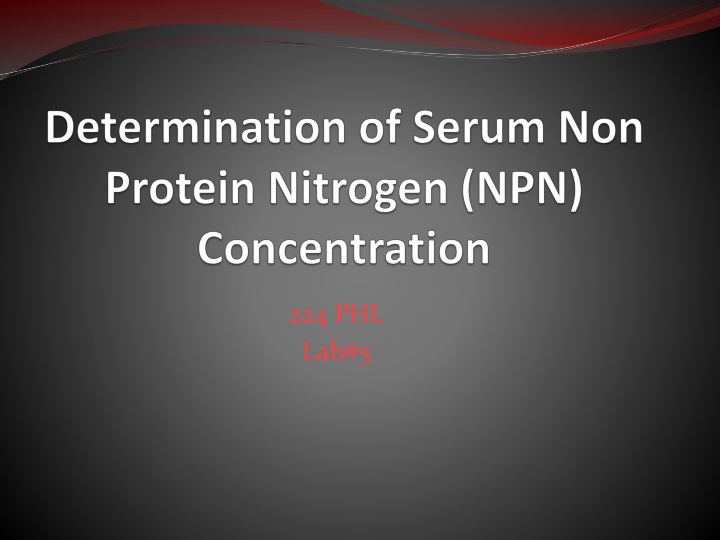
Non-Protein Nitrogen (NPN) and Serum Urea Concentration
Non-protein nitrogen (NPN) includes nitrogen from substances other than proteins, such as urea, uric acid, and ammonia. Testing NPN in blood is important for assessing kidney function, with urea being a key indicator. The determination of serum urea concentration involves the principle of urease converting urea to ammonia and CO2. Elevated blood urea nitrogen levels can indicate various renal and post-renal causes, highlighting the significance of monitoring NPN levels in clinical settings.
Download Presentation

Please find below an Image/Link to download the presentation.
The content on the website is provided AS IS for your information and personal use only. It may not be sold, licensed, or shared on other websites without obtaining consent from the author. If you encounter any issues during the download, it is possible that the publisher has removed the file from their server.
You are allowed to download the files provided on this website for personal or commercial use, subject to the condition that they are used lawfully. All files are the property of their respective owners.
The content on the website is provided AS IS for your information and personal use only. It may not be sold, licensed, or shared on other websites without obtaining consent from the author.
E N D
Presentation Transcript
224 PHL Lab#5
Non-protein nitrogen (NPN) NPN includes the nitrogen from all nitrogenous substances other than proteins. The NPN could be measured as a group or individually. Major Constituents: Urea, uric acid, creatinine, ammonia etc.
Importance of NPN: Testing NPN in blood served as a test for kidney functions. Now it is replaced by determination of urea nitrogen because: (1) The route of elimination of various NPN compounds differs considerably. Some are excreted by glomerular filtrations only e.g. creatinine. Uric acid is excreted by tubular excretion. Urea is excreted by glomerular filtration and then partially absorbed by the tubules. (2) The increase of NPN is mainly a reflection of increase of urea nitrogen which normally makes up 45% of the total NPN.
Determination of Serum Urea Concentration Urea is the end product of protein metabolism in the body. It is synthesized in the liver from the (NH2) amino group resulting from deamination of amino acids.
Principle: urease Urea + H2O ----------> 2NH4 + CO2
Procedure: sample standard Serum sample 0.1 ml standard 0.1 ml Working reagent 1 ml 1 ml Incubate for at 37 C for 5 min, then read the absorbance against blank at = 520nm. Normal serum level: 3.5 7.2 mg/dl. * Incubate at 37 C for 5 min, then read the absorbance after 30 seconds (A1), then read after 60 seconds (A2) against blank at = 340 nm. Normal serum level: 3.5 7.2 mg/dl. ,
Calculation: Serum Urea conc. = A sample/A standard x Conc. Of St. (53.57) = mg/dl. Normal value: (10-50 mg/dl)
Clinical Significance: Increase in blood urea nitrogen could be due to: Pre-Renal Causes: 1) Salt and water depletion. 2) Protein catabolism as in fever. Renal Causes: 1)Glomerulonephritis . 2) Mercury poisoning. 3) Hyperparathyroidism. 4)Hypervitiminosis D. destruction of kidney tissue. cause in serum Ca and precipitation of Ca in the kidney tissue causing
Clinical Significance: Increase in blood urea nitrogen (hyperuremia) could be due to: Post-Renal Causes: 1) Prostate enlargement. 2) Stones in urethra. 3) Tumor of the bladder. cause obstruction to urine flow producing back pressure on the kidney and kidney damage.
Decrease in blood urea nitrogen (hypouremia) could be due to : 1) Liver failure. 2) Malnutrition. 3) Over hydration. 4) Early stages of pregnancy.
Determination of Serum Uric Acid Concentration Uric acid is the end product of purine metabolism. It comes from endogenous metabolism of nucleoproteins and exogenously from food.
Principle: uricase Uric acid + O2 + 2H2O ---------> Alantoin + CO2 + H2O2. peroxidase 2H2O2 + 4-aminoantipyrine + DCFS --------------> quinoneimine + 4H2O.
Procedure: sample standard Serum sample 0.2 ml standard 0.2 ml Working reagent 1 ml 1 ml Incubate for at 37 C for 5 min, then read the absorbance against blank at = 520nm. Normal serum level: 3.5 7.2 mg/dl. * Incubate at 37 C for 5 min, then read the absorbance against blank at = 520nm. Normal serum level: 3.5 7.2 mg/dl. ,
Calculation: Serum Uric acid conc. = A sample/A standard x Conc. Of St. (6 mg/dl) = mg/dl. Normal value: 3.4 7 mg/dl
Clinical Significance: Increase in uric acid Hyperuricemiacould be due to: Decrease in uric acid Hypouricemia could be due to: 1. Hepatitis. 2. Uricosuric drugs: salicylates, phenylbutazone. 3. Fanconi syndrome. 1.Gout . 2. Toxemia. 3. Leukemia. 4. Age: menopausal women. 5. Drugs:Thiazide diuretics.
Determination of Serum Creatinine Concentration : Creatinine is the internal anhydride derived from dephosphorylation of creatine phosphate. Creatine Creatinine + H2O Creatinine has no useful function and is eliminated in urine by glomerular filtration.
Determination of Serum Creatinine Concentration : It is not reabsorbed by the tubules to any significant extent, Therefore glomerular damage will decrease the rate at which creatinine is excreted. Creatinine clearance test can be used as a test for kidney function as its excretion parallels the glomerular filtration rate (GFR). A serum creatinine level over 2 mg/dl indicates Renal Failure.
Principle: Creatinine in the sample reacts with picrate in alkaline medium forming a colored complex.
Procedure: sample standard Serum sample Incubate for at 37 C for 5 min, then read the absorbance against blank at = 520nm. Normal serum level: 3.5 7.2 mg/dl. 0.1 ml standard 0.1 ml Working reagent 1 ml 1 ml * Mix then read the absorbance against blank at = 546 nm after 20 seconds (A1). * Then read after 80 seconds (A2). Normal serum level: 3.5 7.2 mg/dl. ,
Calculation: Serum Creatinine conc. = (A2-A1) sample/(A2-A1) standard x Conc. Of St. (2 mg/dl) = mg/dl. Normal value: (0.6 - 1.1 mg/dl)
